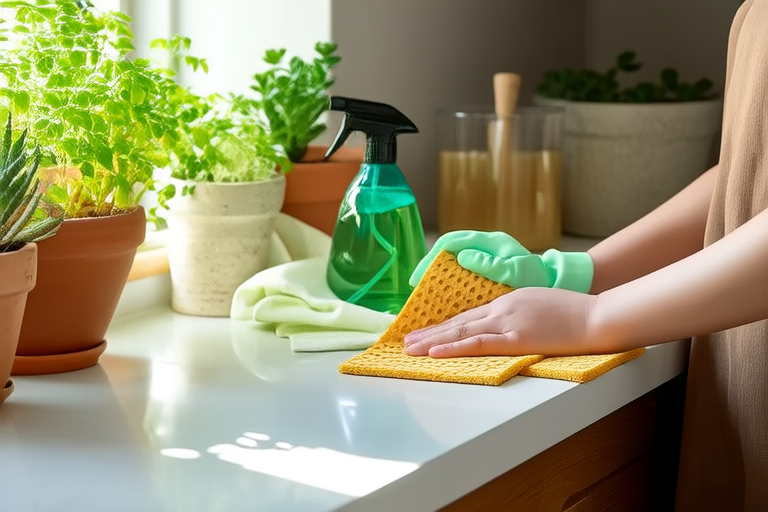Discover the Best Green Cleaning Methods to Protect Both Planet and Health
Introduction: The Importance of Green Cleaning
In today’s world, where environmental sustainability and personal health are increasingly important, green cleaning has emerged as a crucial practice. Traditional cleaning products often contain harsh chemicals that can harm both the environment and our health. By adopting green cleaning methods, you not only reduce your carbon footprint but also create a safer living space for yourself and your loved ones. This article will guide you through the best green cleaning methods, offering practical tips and actionable advice to help you protect both planet and health.
Understanding Green Cleaning
What is Green Cleaning?
Green cleaning refers to the use of environmentally friendly cleaning products and techniques that minimize the use of toxic substances. These products are typically made from natural ingredients like vinegar, baking soda, and essential oils. They are designed to be biodegradable, non-toxic, and sustainable, ensuring that they do not contribute to pollution or harm ecosystems.
Why Choose Green Cleaning?
Choosing green cleaning methods offers numerous benefits. First, it helps protect the environment by reducing the release of harmful chemicals into waterways and air. Second, it promotes better indoor air quality, which is especially important for people with respiratory issues. Lastly, green cleaning products are often less expensive and more accessible than their chemical counterparts.
Essential Ingredients for Green Cleaning
Vinegar
Vinegar is one of the most versatile and effective ingredients in green cleaning. Its acidity makes it an excellent disinfectant and degreaser. You can use white vinegar for general cleaning tasks such as wiping down surfaces, cleaning windows, and removing stains. For a stronger solution, mix equal parts vinegar and water in a spray bottle.
Baking Soda
Baking soda, or sodium bicarbonate, is another powerhouse ingredient in green cleaning. It is a mild abrasive that can effectively scrub away dirt and grime without scratching surfaces. Baking soda is particularly useful for cleaning sinks, toilets, and ovens. To make a paste, mix baking soda with water until it forms a thick consistency, then apply it to the surface you want to clean.
Essential Oils
Essential oils add a pleasant scent to your cleaning routine while providing additional antibacterial properties. Tea tree oil, lemon oil, and lavender oil are popular choices for their refreshing aromas and cleansing abilities. Add a few drops of your favorite essential oil to your cleaning solutions for a natural and fragrant experience.
Practical Green Cleaning Tips
DIY Cleaning Solutions
Creating your own cleaning solutions at home is both cost-effective and eco-friendly. Here’s a simple recipe for an all-purpose cleaner:
- Ingredients:
– 1 cup water
– 1 cup white vinegar
– 1 tablespoon dish soap
– 10 drops of your preferred essential oil (optional) - Instructions:
1. Mix all ingredients in a spray bottle.
2. Shake well before each use.
3. Spray on surfaces and wipe clean with a microfiber cloth.
This solution can be used for countertops, floors, and even bathrooms. It’s gentle yet effective, making it perfect for daily cleaning tasks.
Microfiber Cloths
Microfiber cloths are a must-have tool for any green cleaning arsenal. Unlike traditional paper towels, microfiber cloths are reusable and highly absorbent. They trap dirt and dust particles, leaving surfaces streak-free and shiny. Use them for dusting, polishing, and cleaning glass surfaces.
Steam Cleaning
Steam cleaning is an efficient and chemical-free method for sanitizing surfaces. Steamers use hot water vapor to penetrate and lift dirt, grease, and bacteria. They are ideal for cleaning carpets, upholstery, and tiles. Investing in a steam cleaner can significantly reduce your reliance on chemical cleaners.
Real-Life Applications and Case Studies
Case Study: A Family’s Journey to Green Cleaning
Meet the Johnson family, who decided to switch to green cleaning after noticing a decline in their daughter’s asthma symptoms. Initially skeptical, they started small by replacing chemical-based cleaners with vinegar and baking soda solutions. Within weeks, they noticed a significant improvement in indoor air quality. Their daughter’s asthma attacks became less frequent, and the overall atmosphere in their home felt fresher and healthier.
Actionable Steps for Implementing Green Cleaning
- Assess Your Current Cleaning Products: Take stock of the cleaning products you currently use and identify those that contain harmful chemicals.
- Start Small: Begin by replacing one or two products with green alternatives. Gradually transition to a fully green cleaning routine.
- Educate Yourself: Learn about the benefits of green cleaning and stay informed about new products and techniques.
- Involve the Whole Family: Encourage everyone in your household to participate in maintaining a green cleaning environment.
Conclusion: Embrace Green Cleaning for a Healthier Future
In conclusion, adopting green cleaning methods is a simple yet powerful way to protect both the planet and your health. By using natural ingredients and sustainable practices, you can create a cleaner, safer living space. Remember, every small change counts. Start with one product today and gradually build a comprehensive green cleaning routine. Not only will you enjoy a healthier home, but you’ll also contribute to a more sustainable future for generations to come.
